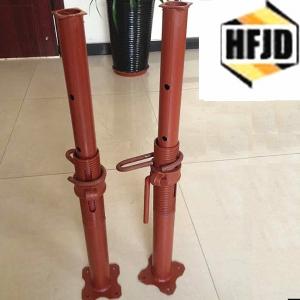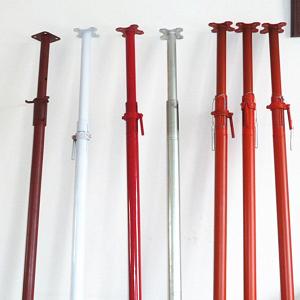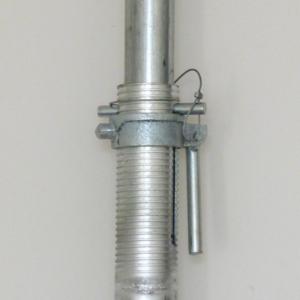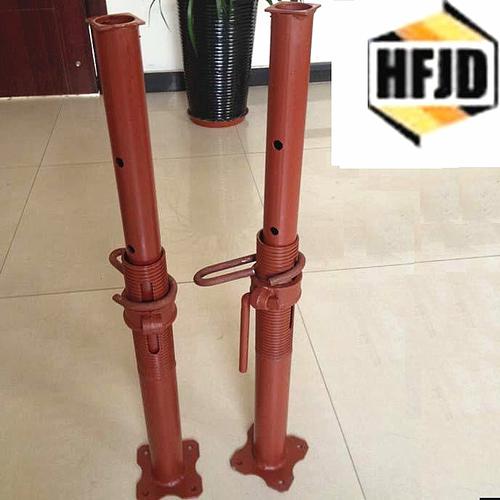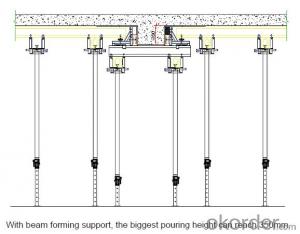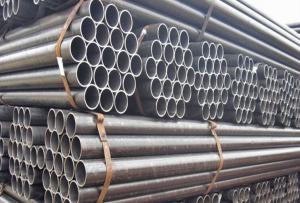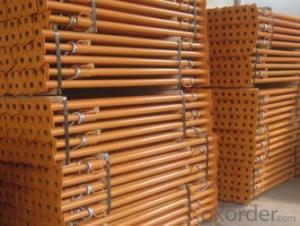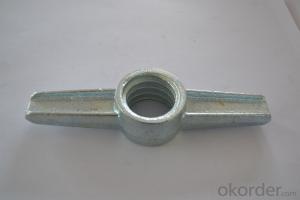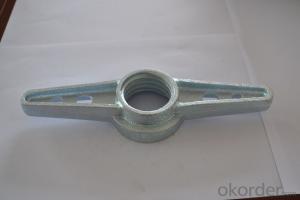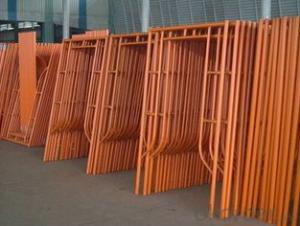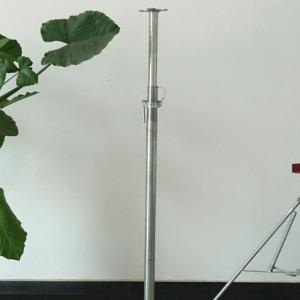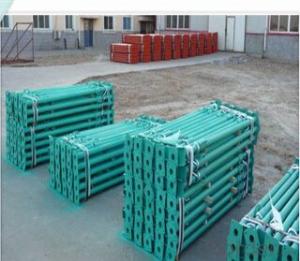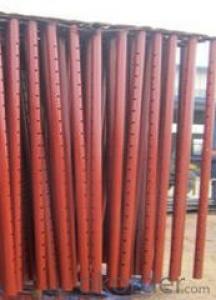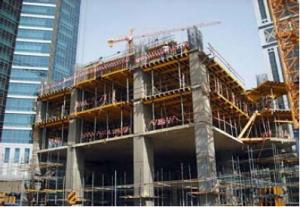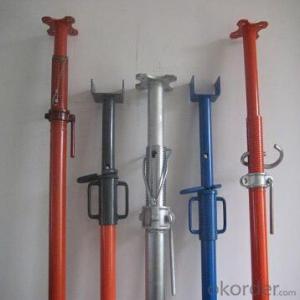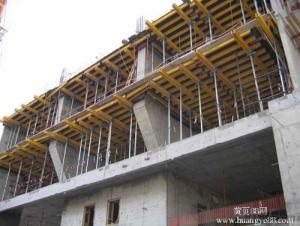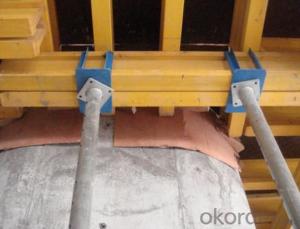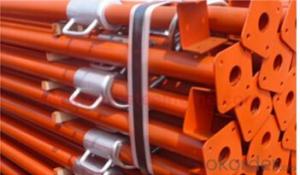Falsework adjustable Scaffolding props
- Loading Port:
- Tianjin
- Payment Terms:
- TT OR LC
- Min Order Qty:
- -
- Supply Capability:
- 180000 pc/month
OKorder Service Pledge
OKorder Financial Service
You Might Also Like
Product name: scaffolding prop
Type:italian ,German,Spanish,Middle East prop, steel pipe surpport.
Adjustable height:0.8-5.5m
Pipe/Tube tickness:1.5mm-4mm
Innner Diameter:40mm,48mm,etc.
Outer Diameter:48mm,56mm,60mm,etc.
Plate type:square,flower/clover,U-head
Nut type: single handle(common,7-style, big 7-style),Cup-style/Double handle
Pin type:line stright with metal cap,line straight without metal cap,chain,G-style
Plate size:120*12*4mm,120*120*5mm,140*140*5mm/5.5mm,etc.
Surface treatment: painted,galvanized,powder coating
Color:orange,red,blue,green,white,etc.
OEM ACCEPTABLE
Fast delivery wihtin 30days
Professional and reliable
- Q: Can steel props be used for supporting temporary concert stages or platforms?
- Indeed, for the purpose of supporting temporary concert stages or platforms, steel props prove to be a suitable option. Referred to as adjustable props or acrow props, these props are commonly utilized in construction and temporary structures in order to furnish support and stability. They are designed with the capacity to bear heavy loads and can be conveniently adjusted to attain the desired height. When it comes to the task of supporting temporary concert stages or platforms, steel props emerge as an ideal selection. One can position them strategically underneath the stage or platform to distribute weight evenly, guaranteeing stability. Moreover, their adjustable nature permits precise leveling and customization to accommodate varying stage heights or irregular ground surfaces. Steel props are manufactured from high-quality steel and are engineered to endure substantial loads, rendering them reliable and robust. Additionally, they are effortless to install and dismantle, a crucial feature for temporary structures such as concert stages or platforms that necessitate prompt setup and teardown. In conclusion, steel props offer the essential support and stability that temporary concert stages or platforms require. They represent a dependable and pragmatic solution for ensuring the safety and durability of such structures.
- Q: What are the guidelines for the proper installation and removal of steel props?
- The guidelines for the proper installation and removal of steel props involve several key steps to ensure safety and effectiveness. Here are the general guidelines to follow: 1. Preparation: Before installation, assess the site conditions and ensure it is suitable for steel props. Check for any potential hazards or obstructions that may affect the installation process. 2. Selection of props: Choose the appropriate type and size of steel props based on the load-bearing requirements and the height of the structure being supported. Ensure the props are in good condition, free from any defects or damages. 3. Installation: Begin by placing the base plate of the steel prop onto a stable and level surface. Make sure the prop is vertical and aligned with the load-bearing point. Extend the prop to the desired height by adjusting the inner tube and secure it by tightening the locking pin or collar. 4. Load distribution: Ensure that the load is evenly distributed across the prop's base plate. Use timber or steel sole plates under the base plate if necessary to distribute the load over a larger area. This prevents excessive pressure on the ground or floor. 5. Bracing and stability: To enhance stability, use diagonal bracing or ties between the steel props and the supported structure. This helps prevent lateral movement or collapse in case of any unexpected forces. 6. Regular inspections: Monitor the steel props regularly during the installation process to identify any signs of instability, bending, or damage. If any issues are detected, take immediate action to rectify them or seek professional assistance. 7. Removal: When removing steel props, gradually reduce the load on each prop, taking care not to cause any sudden shifts or collapses. Loosen the locking pin or collar and lower the prop's inner tube slowly and steadily, ensuring a controlled descent. 8. Maintenance and storage: After removal, inspect the steel props for any damages or wear. Clean them thoroughly and store them in a dry and secure location to prevent rust or deterioration. Regularly maintain and service the steel props to prolong their lifespan. Remember, it is crucial to follow manufacturer guidelines and local regulations specific to your region when installing and removing steel props.
- Q: Are steel props suitable for use in high-rise buildings?
- Yes, steel props are suitable for use in high-rise buildings. Steel props provide strong support and stability, making them ideal for supporting heavy loads and ensuring the structural integrity of tall buildings. They are adjustable in height, allowing for flexibility during construction and the ability to accommodate varying floor levels. Additionally, steel props are durable and resistant to fire, making them a reliable choice for high-rise construction projects.
- Q: How do you ensure proper stability when using steel props on soft ground?
- To guarantee adequate stability while using steel props on soft ground, several essential precautions can be taken: 1) Ground Evaluation: Before implementing steel props, it is imperative to evaluate the ground conditions. Soft ground may consist of soil with low bearing capacity or susceptible sinking areas. Conducting a comprehensive assessment of the ground will aid in determining the necessary measures to be implemented. 2) Load Distribution: The pressure exerted on the soft ground can be reduced by distributing the load over a wider area. This can be achieved by utilizing larger base plates or timber mats to evenly distribute the load. 3) Depth and Size of Props: When working on soft ground, it is advisable to consider employing longer and thicker diameter steel props. Longer props will provide enhanced stability by reaching deeper, more stable layers of soil. Similarly, larger diameter props will distribute the load more evenly, minimizing the risk of sinking. 4) Reinforcement: In certain cases, additional reinforcement may be necessary to augment stability. This can be accomplished by incorporating steel plates or beams to provide supplementary support to the props. Reinforcement will aid in more effectively distributing the load and mitigating the risk of sinking. 5) Regular Monitoring: Continuous monitoring of the stability of the steel props and ground conditions throughout the project is crucial. Regular inspections will help identify potential issues or instability and enable prompt corrective actions to be taken. By adhering to these precautions, proper stability can be guaranteed when employing steel props on soft ground, thereby reducing the occurrence of accidents and ensuring the safety of workers and the surrounding environment.
- Q: How do you ensure proper alignment of steel props?
- Achieving proper alignment of steel props can be accomplished by following several steps: 1. Inspection: Before use, thoroughly examine the steel props for any indications of damage or defects. Inspect for any bent or dented components, signs of rust or corrosion, and confirm that all locking pins and fasteners are securely in place. 2. Leveling: Position the steel props on a stable and even surface. Utilize a spirit level or laser level to verify the vertical alignment of the props. Adjust the base plates or footings as needed to ensure they are sitting squarely on the ground. 3. Plumb line: Employ a plumb line or plumb bob to assess the vertical alignment of the steel props. Attach the plumb line to the top of the prop, allowing it to hang freely. Confirm that the line is perfectly vertical and make adjustments to the prop as necessary to achieve proper alignment. 4. Bracing: Maintaining alignment and stability of the steel props depends on proper bracing. Install diagonal braces between the props to prevent lateral movement or collapse. These braces should be securely fastened and regularly inspected to ensure they are not loose or damaged. 5. Regular checks: Throughout the project duration, consistently inspect the steel props to ensure they remain correctly aligned. This involves checking for any signs of movement, loose connections, or shifting of the props. If any issues are identified, take immediate action to rectify them. 6. Removal: When removing the steel props, adhere to appropriate procedures to prevent sudden movement or collapse. Always ensure that the load is fully supported by an alternative means before removing the props. This safeguards against misalignment or damage during the removal process. By adhering to these steps, one can guarantee the proper alignment of steel props, which is vital for the safety and stability of the supported structure.
- Q: How do you prevent steel props from sliding on icy surfaces?
- To prevent steel props from sliding on icy surfaces, there are several measures you can take: 1. Use anti-slip mats or grips: Place rubber or anti-slip mats underneath the steel props to provide traction and prevent them from sliding. These mats are designed to grip onto the icy surface and create friction, ensuring stability. 2. Secure props with straps or clamps: Use straps or clamps to secure the steel props to nearby structures, such as walls or poles. This will help stabilize the props and prevent them from sliding on the icy surface. 3. Add weight or ballast: Increasing the weight on the steel props can improve stability and reduce the likelihood of sliding. You can attach additional weights to the props or use sandbags as ballast to anchor them down. 4. Create a stable base: Clear any snow or ice from the ground where the steel props will be placed. Level the surface and ensure it is free from any debris that could affect stability. If possible, create a stable base by using plywood or other flat materials to provide a solid foundation for the props. 5. Use ice melt or traction aids: Apply ice melt or other traction aids to the surface around and underneath the steel props. These substances can help melt the ice and improve grip, reducing the chances of sliding. 6. Monitor and maintain: Regularly inspect the props and the surrounding area for any signs of movement or instability. If necessary, readjust the props, add more traction aids, or reinforce the stability measures to maintain a secure setup. It is crucial to prioritize safety and take necessary precautions when working with steel props on icy surfaces. By implementing these preventive measures, you can minimize the risk of sliding and ensure a stable and secure setup.
- Q: What is the lifespan of a steel prop?
- Various factors, including usage, maintenance, and environmental conditions, can affect the lifespan of a steel prop. Typically, a steel prop that is well-maintained can endure for several years. By conducting regular inspections, making necessary repairs, and storing it appropriately, the steel prop can be utilized in numerous construction projects. Nonetheless, it is crucial to acknowledge that wear and tear may occur over time, potentially compromising the prop's load-bearing capacity and structural integrity. Consequently, periodically evaluating the condition of the steel prop and replacing it when necessary is recommended to guarantee safety and effectiveness in construction operations.
- Q: Are steel props suitable for supporting temporary agricultural structures or greenhouses?
- Steel props are indeed appropriate for the support of temporary agricultural structures or greenhouses. As a robust and long-lasting material, steel possesses the capability to offer the essential support required by these structures. It can effectively bear the weight of the structure, while also withstanding external conditions like wind or snow loads. Furthermore, steel props can be effortlessly modified or extended to adapt to the evolving demands of agricultural structures or greenhouses. This characteristic makes them a versatile and pragmatic option for temporary support in agricultural settings.
- Q: Are steel props suitable for supporting temporary signage or billboards?
- Yes, steel props are suitable for supporting temporary signage or billboards. Steel props are commonly used in construction and are designed to provide sturdy support for various structures. They are made from high-quality steel, which makes them strong and durable. Steel props can be easily adjusted to the desired height and are capable of supporting heavy loads. Additionally, they have a wide base and offer stability, which is crucial for supporting temporary signage or billboards, especially in outdoor environments where wind and other weather conditions may pose a challenge. Overall, steel props are a reliable and effective choice for supporting temporary signage or billboards.
- Q: Can steel props be used in the construction of art galleries?
- Certainly, art galleries can utilize steel props in their construction. Steel props are widely employed in construction projects to bolster and fortify various edifices, including art galleries. They furnish robust and trustworthy support, thereby being suitable for heavy burdens and guaranteeing the security and steadfastness of the building. Art galleries often necessitate particular design components like expansive empty areas, lofty ceilings, and distinctive architectural characteristics to effectively exhibit artwork. Steel props can be utilized to generate these features by providing structural reinforcement for vast spans, enabling open floor plans, and allowing the erection of lofty ceilings without the requirement of supplementary columns or walls. Additionally, steel props present design versatility as they can be conveniently customized to meet precise requisites and architectural concepts. They can be employed to fabricate intricate and aesthetically appealing designs without compromising on the structural soundness of the building. This enables art galleries to possess a visually captivating and practical space that is conducive to exhibiting artwork. Moreover, steel props are long-lasting and possess excellent load-bearing capacities, rendering them appropriate for supporting hefty artwork, sculptures, or installations. They can endure the weight of substantial pieces and ensure the artwork remains secure and stable, thereby diminishing the risk of damage. In conclusion, steel props can be efficaciously employed in the construction of art galleries as they offer dependable structural support, permit distinctive design elements, and guarantee the safety and stability of the building. Their adaptability, durability, and load-bearing capabilities make them an ideal option for creating functional and visually enticing spaces to display artwork.
Send your message to us
Falsework adjustable Scaffolding props
- Loading Port:
- Tianjin
- Payment Terms:
- TT OR LC
- Min Order Qty:
- -
- Supply Capability:
- 180000 pc/month
OKorder Service Pledge
OKorder Financial Service
Similar products
Hot products
Hot Searches
Related keywords
